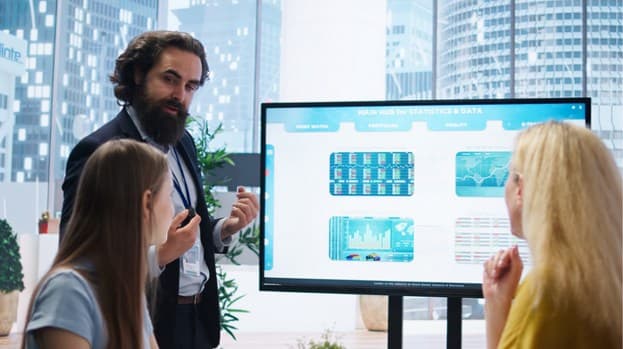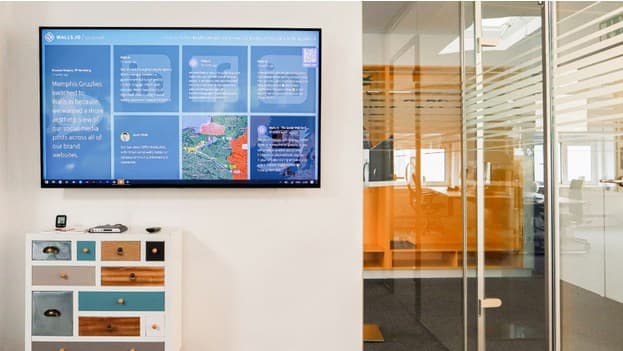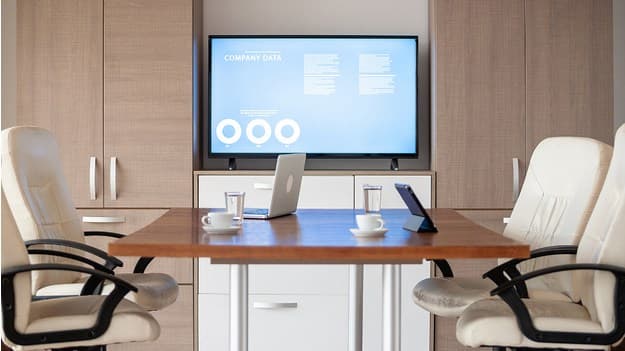Sometimes important company updates get missed. Emails can pile up, and people are busy with their day. So, how do you make sure your team sees what matters?
That's where digital signage can help. It turns screens in break rooms, hallways, and offices into tools that share real-time updates. From company news to team wins, it keeps everyone in the loop.
In this post, you'll find creative ways to use digital signage for employee communication, plus helpful tips to set it up and keep it running smoothly.
Main Takeaways:
- Digital signage helps make sure all employees see important updates in real time
- It keeps teams engaged by showing wins, sharing live data, and supporting a strong company culture
- Placing screens in busy areas and using a mix of scheduled content helps keep messages fresh and useful
- Choosing easy-to-use software that can grow with your company is important for long-term success
- OptiSigns makes it simple to manage content, schedule updates, and connect with tools you already use
What Is Digital Signage for Internal Communications?

Digital signage for internal communications is a way to share information with employees using screens placed around the workplace. Instead of relying on email or printed posters, messages are shown on digital displays where people can easily see them.
This system includes three main parts:
- Screens or monitors that show the content
- Content management software to control what is displayed
- An internet or network connection to send updates to the screens
Companies can use these systems to show things like announcements, schedules, safety messages, or company updates. The content can be created, updated, and managed from one central platform, making it easy to show the same or different messages across multiple locations.
Why Digital Signage Helps Teams Stay Connected
Screens are still one of the best ways to share information at work. Digital signage turns everyday screens—like breakroom TVs or hallway monitors—into tools that help teams stay informed. Messages are easy to see and don't get lost in email or apps.
This is especially helpful for workers who don't sit at a desk. Whether someone is in the office, working remotely, or on the floor, they can all see the same updates at the same time. Digital signage keeps everyone in the loop.
When employees feel informed, they are almost five times more likely to say they're productive. Having a shared space for updates makes a big difference in how people feel about their work and their role in the company.
Here's how digital signage compares to traditional ways of sharing information:
Digital signage creates a shared spot where everyone can stay informed, feel included, and stay focused without needing to check their phone or inbox. It's a straightforward way to bring teams together and maintain clear communication.
12 Creative Ways to Use Digital Signage for Employee Communication

Here are 12 great ways to use your screens to support communication and culture across your workplace.
1. Celebrate Employee Achievements
Use your screens to spotlight team members who've done a great job. This could be finishing a big project, helping a coworker, or reaching a goal. Add their name, photo, and a short message like "Thanks for going above and beyond!" to make it personal and meaningful.
Sharing achievements shows employees that their work matters. It also sets a positive tone across the workplace. When one person is recognized, others feel motivated to do their best too.
2. Share Team Goals and Progress
Keep your team on track by posting goals and showing how close you are to reaching them. For example, show weekly sales totals or customer satisfaction scores. Use simple visuals like charts or checkmarks to make the numbers easy to follow.
Seeing real-time progress helps employees stay focused and work toward shared goals. It also reminds them that their day-to-day efforts are part of something bigger.
3. Welcome New Hires
Starting a new job can be tough. Make new team members feel welcome with a quick message on your screens. Include their name, photo, and department so coworkers can say hello and help them feel at home.
This small gesture makes a big difference. It helps new employees feel included right away and shows that your company cares about people, not just work.
4. Promote Upcoming Events
Use your screens to remind employees about events like team meetings, training sessions, or company lunches. This is especially helpful in busy workplaces where emails can be missed or forgotten.
A short message with the date, time, and location keeps everyone in the loop. You can also add a fun graphic or countdown to make the reminder stand out.
5. Highlight Birthdays and Work Anniversaries
Celebrating birthdays and work anniversaries on your screens is a simple way to show appreciation. You can post the employee's name, photo, and a cheerful message like "Happy 3 Years, Carlos!"
These small celebrations make people feel noticed and valued. They also bring more positive energy into the workplace and give coworkers a reason to connect.
6. Share Health and Safety Tips
Post reminders to help your team stay safe and healthy. These can be safety rules, emergency steps, or tips like "Drink more water" or "Wear your safety glasses."
Screens are especially helpful in busy or loud work areas. A bright, simple reminder on a screen can reach more people than a printed sign or email—and it's easy to update as rules or seasons change.
7. Post Shift Updates and Work Schedules
Keep your team on track by posting shift times and job assignments. You can use the screens to show changes like "Team A starts at 7 AM this week" or "Lunch break is now at 12:30."
This helps reduce confusion and saves time. When employees can check the screen at the start of their shift, they don't need to ask a manager or search for a printed list.
8. Promote Learning Opportunities
Let employees know about training sessions, workshops, or new job openings. A quick message like "Sign up for First Aid Training by Friday" makes it easy for staff to take action.
Showing learning opportunities on screens encourages growth and helps employees take the next step in their careers. It also shows that your company supports learning and development.
9. Share Company News and Updates
Keep everyone in the know by posting news like new office openings, leadership changes, or company goals. Use short, clear messages that make the updates easy to understand.
Sharing news builds trust and helps employees feel like they're part of something important. It also reduces the need for long emails or printed memos that often go unread.
10. Show Social and Team Highlights
Bring your team's personality to the screen. Post group photos from events, employee spotlights, or quotes from staff. You can even share fun facts or team challenges.
These moments help people feel connected. It's a great way to build community, especially in larger companies where people may not see each other every day.
11. Display Helpful Reminders
Screens are perfect for short reminders that help employees stay on track. This could be a deadline, a task, or a tip like "Submit your timesheet by 4 PM" or "Update your password today."
These visual cues help cut down on missed tasks and follow-up emails. It's a quick and friendly way to keep things running smoothly without extra noise.
12. Share Location-Specific Content
Not every message needs to go to everyone. Use your screens to show content that fits the area it's in. For example, warehouse screens can show safety tips or shift updates, while break room screens highlight team birthdays or HR reminders.
This makes your messages more useful and relevant. It also shows employees that you're thinking about what matters most in their space, not just company-wide news.
Best Practices for an Effective Internal Digital Signage Program

You've just learned how digital signage can help you share messages, celebrate your team, and keep everyone in the loop. Now it's time to set it up the right way. These simple tips will help you get started, keep things running smoothly, and make sure your screens stay useful as you grow.
1. Set a Clear Goal
Before you begin, decide what you want your signage to do. Start with one or two simple goals, like:
- Cutting down on email overload
- Sharing safety tips
- Recognizing employees
- Keeping remote teams in the loop
Having a clear purpose helps guide your content choices and track your success over time.
2. Choose the Right Screen Locations
Place screens where employees are most likely to notice them:
- Break rooms
- Hallways and entryways
- Near time clocks or elevators
Match the content to the location. For example, safety reminders near work zones and event updates near gathering areas.
3. Start Small and Grow Over Time
You don't need a large setup right away.
- Begin with one or two screens in high-traffic areas
- Test different content types and layouts
- Ask for feedback from your team
- Add more screens and locations once you know what works
This helps you avoid mistakes and build confidence as your signage grows.
4. Use Simple, Reliable Tools
Pick software that is easy for anyone to use. Look for:
- Drag-and-drop design tools
- Built-in templates
- Easy content scheduling
- Support for automatic updates
OptiSigns includes these features and connects with tools like Power BI, Google Sheets, calendar apps, and social media platforms.
5. Stay Organized With Templates and Clear Roles
Make content creation easier by using branded templates with your company's colors and fonts. This keeps everything looking consistent.
Also, create a clear workflow:
- Decide who makes the content
- Decide who reviews and approves it
- Set rules for what gets published and when
6. Keep Content Fresh With Scheduling and Automation
Mix up your content to keep screens engaging. Plan a schedule that includes a variety of content, like:
- News and updates in the morning
- Team highlights around lunch
- Reminders or fun content in the afternoon
Use automation tools to connect your screens to live data. This helps your signage update itself, saving your team time and effort.
7. Use Secure Systems and Permission Settings
Digital signage runs on your network, so security matters.
- Use strong passwords and safe internet connections
- Choose a system that supports user roles and approval workflows
- Only give content access to team members who need it
- Follow data privacy rules if you show sensitive info
Platforms like OptiSigns use encryption and user permissions to keep your system safe.
8. Choose Hardware That Fits Your Space
Pick screens and media players that work well in each area. Think about:
- Screen size and brightness
- Durability in busy or industrial spaces
- Mounting needs or space limitations
OptiSigns works with most screens and offers plug-and-play devices that are easy to install and maintain.
9. Pick a Platform That Can Grow With You
Choose a digital signage solution that can scale as your company grows. Make sure it's easy to:
- Add more screens
- Support multiple users
- Expand to new locations
The best tools let you grow without needing to start over or change systems.
10. Measure What's Working
Track how your signage is performing with built-in reporting tools. Keep an eye on:
- Viewership – how many people see your screens
- Engagement – how people interact with your content
- Information recall – how well people remember what they saw
Also, gather feedback from employees using:
- Quick QR code surveys
- "Was this helpful?" buttons
- Short monthly check-ins
Use what you learn to improve your content mix and make communication even better over time.
Make Your Workplace Better with OptiSigns
Digital signage helps your team stay connected, feel appreciated, and stay up to date—no matter where they work. It takes your messages out of email and puts them where people will actually see them, like in break rooms, hallways, or near workstations.
With OptiSigns, you get everything you need to make it easy. Use templates, connect to real-time data, and manage all your screens from one place. Whether you have one screen or many, OptiSigns helps you share the right message at the right time.










